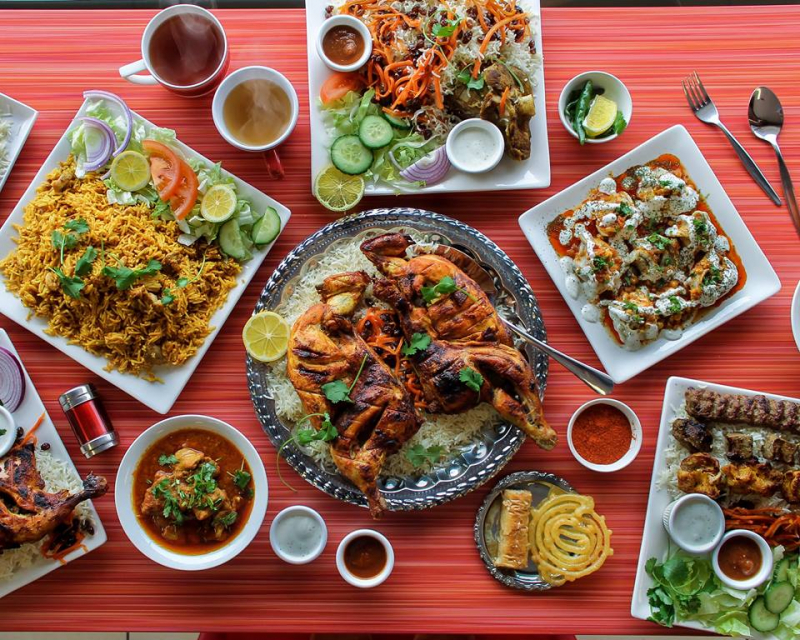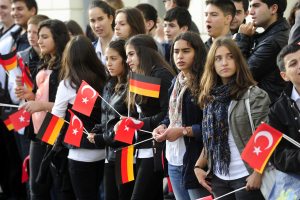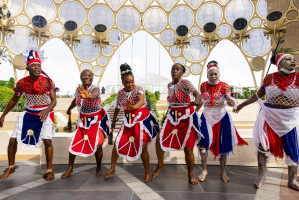Top 9 Afghanistan Culture, Customs, and Traditions
Afghanistan has a deep and diversified culture that has evolved over many centuries. The Achaemenid Empire of the sixth century BCE is where Afghani culture ... read more...first emerged. Islam has an impact on Afghanistan's culture. Dari and Pashto are the two recognized official languages in the nation. Western cultural influences have permeated Afghani culture as a result of modernization, and this is particularly pronounced in the nation's largest cities. Here are some Culture, Customs, and Traditions in Afghanistan.
-
Afghanistan's culture is fundamentally shaped by religion, which also has an impact on other areas of national life. In Afghanistan, 99.7% of people identify as Muslims, making Islam the dominant religion in the nation. However, Zoroastrianism, which is thought to have its roots in Afghanistan reaching back to the 18th century BC, is the oldest religion still practiced today in that nation. Zoroastrians are thought to number 2,000 in contemporary Afghanistan. In 305 BC, when Afghanistan was a part of the Maurya Empire, Buddhism first appeared in that country.
Early in the eighth century, Islam was brought to the land, and by the ninth century, it had become the majority religion. About 10% of the population identify as Shia Muslims, compared to 90% of the population who practice Sunni Islam. Additionally, a sizable portion of Muslims in the nation identify as nondenominational and contemporary Muslims. According to estimates, Afghanistan's Christian population numbers between 500 and 8,000 people.
http://www.businessinsider.com/ 
https://pieper5kiterunnerafghanculture.weebly.com -
Afghanistan's cultural diversity is reflected in the styles of clothing that are worn there. Many of the country's traditional outfits are composed of lightweight linen and have loose fittings. The Pashtun dress is one of the most well-liked traditional outfits in Afghanistan. The design of the clothing, which is available in male and female versions, is influenced by Pashtun culture. Traditional headgear, such the perahan turban or the karakul cap, is worn to accessorize male Pashtun apparel.
The female version is typically worn during celebrations and is made up of a Firaq partug garment, a long shirt called a "Kamis," and a belt. On ceremonial occasions, a lot of important Afghan residents and government representatives wore Pashtun attire. The western and northern regions of the nation are home to indigenous weavers who produce the traditional carpets known as Afghan rugs. The carpets are well-liked all around the world and have even frequently taken home prestigious international prizes.

https://www.pinterest.com/ 
https://www.pinterest.co.uk -
Cricket is the most popular sport in the nation and is extremely popular in Afghanistan. It's interesting to note that because of security concerns in Afghanistan during the 1990s and the beginning of the 2000s, the national cricket team of Afghanistan, which represents the nation in international events, played many of its home matches outside of the nation. Another well-liked sport in the nation is football. The Khurasan Lions, the nation's national football team, were established in 1922.
The national football squad did not play in any international matches from 1984 to 2002 despite joining FIFA in 1948 because of domestic political unrest. The Afghanistan national football team has taken part in important football events since making a comeback, such as the South Asia Football Federation Championship and the AFC Challenge Cup.
Their finest result in the competition came when the Khurasan Lions won the 2013 South Asia Football Federation Championship. Basketball is another well-liked sport in Afghanistan, and the national basketball team has taken part in significant basketball contests. In the 2010 South Asian Games, the national basketball team of Afghanistan won the title.

http://nbcnews.com 
https://khelnow.com -
The food in Afghanistan is delicious, healthful, and bursting with flavor. Afghanistan's distinctive flavor characteristics are among the experts' favorites because they are neither either sweet nor overly spicy.
Afghan food reflects the variety of cultures present in the country. Rice, barley, wheat, and maize are grown as staple crops in Afghanistan. Many Afghan kitchens are dominated by rice, and the "Kabuli palaw," a regional rice dish, is regarded as Afghanistan's national meal.
Afghan cuisine also includes a lot of meat, especially lamb and beef. A common food throughout the nation, roasted lamb kebabs may be found on many street vendor carts. Alcohol drinking is uncommon in Afghanistan because it is an Islamic country, and it is mostly seen among expats residing in big cities like Kabul. The "doogh," a popular beverage in the nation prepared with yogurt, water, and mint, is a local favorite. The beverage can be made at home or bought in eateries and grocers.

https://flavorverse.com 
https://medmunch.com/ -
Like many other facets of Afghani culture, music is centered on Islam, the country's primary religion. Afghanistan's traditional music is diverse, with regionally specific traditional musical forms present throughout the nation. Afghanistan's music has also been inspired by Iranian, Pakistani, and Indian culture. The two oldest radio broadcasters in the nation, Radio Kabul and Radio Afghanistan, played a crucial part in the development of the country's music industry. The 1970s marked the peak of the business and the emergence of many notable Afghani musicians.
The pop music industry in Afghanistan saw a boom during this period, launching the careers of Afghan pop stars like Ehsan Aman and Naghma Shaperai. The music business was suppressed by the Taliban rule, but after the Taliban were driven out in the early 2000s, it has undergone a revival. Bollywood music, which is popular in large cities and is especially popular among young people, has also affected music in Afghanistan.
In recent years, Afghanistan has embraced Western musical styles. One such example is hip-hop, which is quite popular in Kabul and even attracted local musicians like Soosan Firooz, who is frequently referred to as the nation's first female rapper. Afghan hip-hop contains both local cultural references and the genre's traditional style.

https://navadance.teachable.com 
https://www.prokerala.com/ -
The Afghani people have included art into their culture for centuries. Afghanistan is home to the oldest oil painting ever discovered. Islam was the focal point of the nation's art for a long time, but in the modern day, artists are finding inspiration in a wide variety of other places. Many of the top painters in Afghanistan present their works at the National Gallery, which also houses a sizable collection of regional art. The National Museum and Archives, both of which are located in Kabul, are additional locations where Afghani art can be viewed.
More than any other country's political or military outlook, Afghanistan has always affected international cultures and heritage. A peek of the region and its inhabitants can be seen in traits like pride in one's own honor and a long history. Physically, the two Afghanistans rarely differ from one another. But the impact of nearby nations and the lingering effects of a devastating civil war have made the populace wary of outside involvement. The Afghan people are hospitable and diligent. The home is the core of their life and work. The highest respect and esteem are shown to women.
https://www.pinterest.com/ 
https://www.activistpost.com/ -
The term "Afghanistan architecture" refers to architectural styles found inside the present nation's borders, which have been mostly unaltered since 1834. The boundaries of the area before this time changed with the swift advance of armies, with the land belonging to a wide range of empires over the previous two millennia. This region served as the connection between the three major cultural and geographic centers of Central Asia, the Indian subcontinent, and the Iranian plateau.
With influences ranging across time from Greek to Persian to Indian to Chinese to European in more recent centuries, Afghan history is as diverse as the country's architecture and architectural relics. A variety of historical religious influences are also discernible, with the majority of the evidence pointing to early Buddhist, Zoroastrian, and Islamic inspiration.In recent battles, Afghanistan has lost a significant number of its historical sites. All around Afghanistan, ruins of architecture from various eras can be found. This location is rich in history and architectural value due to the presence of Buddhist stupas, Buddhist monasteries, and elaborate Islamic minarets, arches, and monuments. The Chel Zina (Forty Steps) and rock carvings created by Mughal ruler Babur at Kandahar, which also holds the prophet's cloak, are both over a thousand years old. The ruins of extravagant and opulent architecture can be found at Ghazni and Balkh. UNESCO has designated the well-known Minaret of Jam as a "heritage site."

https://www.pinterest.com 
https://www.pinterest.com -
Because of its location, the nation has long served as a battlefield for advancing armies and conquerors. The Afghan people are particularly distinctive in some of the practices and traditions they uphold as a result of this recurrent feature.
- The people of Afghanistan adhere to Islamic teachings and have a strong belief in an all-powerful God. They hold that every "believer" is allowed by Islamic law, under the direction of the caliph, to keep weaponry. This requirement primarily results from the location's challenging terrain and challenging living circumstances in the mountains.
- Afghans are notorious for showing intense allegiance to the clans and tribes that make up their various groups, and their identification with Afghanistan as a whole is flimsy. They consider individual honor and responsibility as the cornerstones of social order, and they are incredibly welcoming and devoted people.
- Assalamu Alaikum, which translates to "Peace be with you," is the way Afghans greet one another. Wa Alaikum Assalaam is the response to the greeting, signifying agreement of thinking. The most typical greeting is a handshake, while additional options include putting your hands over your hearts and giving a small nod.
- In Afghanistan, eating is a unique experience, and people typically eat from the same dish together. It is traditional to eat with your hands while sitting on the floor. To eat with your left hand is frowned upon, and you should always leave some food on your plate to prevent it from becoming completely empty.
- In Afghan culture, men and women never shake hands or look each other in the eyes. Only in families are interactions between the sexes unrestricted; in a professional setting, interactions are permitted as long as they don't offend or degrade anyone.

https://iwp.uiowa.edu/ 
http://afghanclothingbellydancekuchijewelry.blogspot.com/ -
Actually, there are some things that you should not do in Afghanistan. And here are some of them.
- For women, sleeveless clothing and wearing skirts are strictly prohibited since they disrespect Afghan culture. In addition to covering their heads and chests, women are not supposed to shake hands with men.
- Do not consume food or beverages, chew gum, or play music in front of local Afghans during the holy month of Ramadan. It is thought to be disrespectful to them.
- No of how acquainted a woman may be, foreign guys shouldn't start a conversation regarding her or any other male relative's wife. There should never be any physical contact between males and women.
- When entering a home, it's customary to take your shoes off, and you shouldn't point your feet in their direction. The more you compliment or like someone's attire or jewelry, the more likely they are to offer it to you.

https://3signs.co.uk/ 
https://www.ebay.com/ - For women, sleeveless clothing and wearing skirts are strictly prohibited since they disrespect Afghan culture. In addition to covering their heads and chests, women are not supposed to shake hands with men.






























